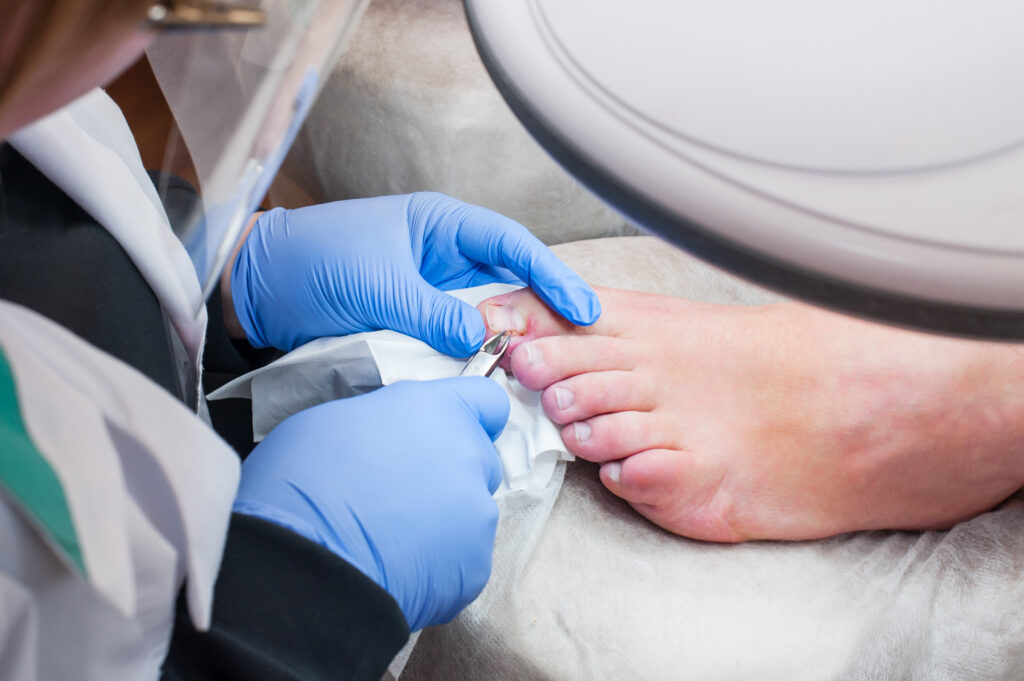
If you’re experiencing spurts of pain, tenderness along the side of your toenail, swelling or redness, and even pus or drainage, you likely have an ingrown toenail. It is a common condition that occurs when the toenail grows into the surrounding skin of the toe.
Ingrown toenails can cause extreme pain and discomfort that impacts day-to-day activities. The real question is, does it raise cause for concern, or do ingrown toenails go away on their own? Keep reading to find out when you can treat an ingrown toenail at home and when it’s time to seek help from a professional.
What Exactly is An Ingrown Toenail?
An ingrown toenail, medically called onychocryptosis, is an uncomfortable condition in which the nail grows into the skin. As the nail grows through the skin, the pain intensifies.
The early stages of an ingrown toenail involve:
- Pain. This might seem like an obvious factor, but what throws people off about the pain is it’s not always constant. It might come and go, which makes it easy to overlook or excuse as something minor.
- Redness and swelling. The skin around the affected area will turn red and swell due to inflammation. By this point, wearing shoes that are too narrow and engaging in movement-centered activities will become noticeably difficult.
- Discharge. When the nail breaks through the skin, bacteria can enter the site and cause an infection. Fluid builds up, and pus and/or blood will come out of the infected area.
If you’ve hit the stage where your toenail has become infected, you should seek medical attention immediately.
Do Ingrown Toenails Go Away On Their Own?
If you’re wondering, “Do ingrown toenails go away on their own?” the answer is maybe; they can, but that doesn’t mean they always do. It all depends on the condition of the ingrown toenail. Treating a painful ingrown toenail before it gets infected is always best.
At that point, it’s best to make an appointment with a podiatrist who can assess your situation and provide the best treatment course, whether topical medication or oral antibiotics. A minor procedure to remove the nail border might be necessary in some cases.
But don’t panic quite yet. If you’re still in the beginning stages of an ingrown toenail, you still have time to try at-home solutions that can provide immediate relief.
No Infection, No Worries: At-Home Care
Healing an ingrown toenail at home takes a little time and patience. Incorporate these steps into your routine for recovery in no time:
- Soak your foot in warm water mixed with Epsom salt 3-4 times daily for 10-20 minutes. Carefully rub the skin along the side of the nail to loosen the soft area. Check out this blog for the best DIY soaking solutions for ingrown toenails.
- Keep your feet clean and dry to avoid bacterial growth.
- Wear spacious or open-toe shoes that will cause little to no irritation to the affected area.
These methods can alleviate pain and aid in the healing process, but if your symptoms are worsening or you have underlying health conditions like diabetes and/or circulation problems, don’t wait to see a professional.
Having Trouble With an Ingrown Toenail?
The answer to “do ingrown toenails go away on their own?” isn’t always straightforward with a quick online search, but we are here to help.
At Foot Specialists of Birmingham, our podiatrists are trained to get you back on your feet. Don’t wait for an infection if the signs are leading up to one. Contact one of our podiatrists at (205) 445-0661 or request an appointment online today!

